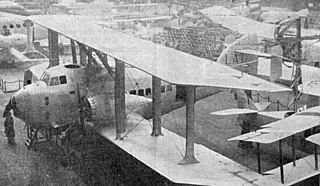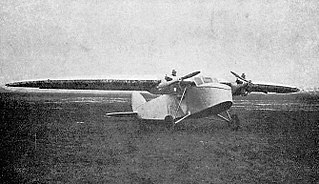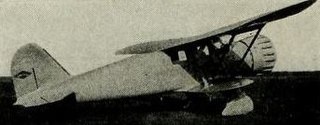
The Latécoère 4 was a three-engined, 15-passenger biplane built in France in the early 1920s. It proved difficult to fly and was discontinued, though a second machine was completed as the Latécoère 5 bomber.
The Comper Kite was a single-engined, two-seat touring monoplane built in the UK, derived from the contemporary Comper Streak racer. Only one was built.
The Nakajima P-1 was a 1930s Japanese single engine, single seat biplane intended for night mail flights, derived from the Nakajima E4N3 Naval reconnaissance seaplane. Nine were built.

The Gwinn Aircar was a single-engined biplane with a cabin for two, designed in the US as a safe and simple private aircraft. Lacking a rudder, it had several unusual control features as well as an early tricycle undercarriage. Development was abandoned after a crash in 1938.
The Alpaero Sirius, also called the Noin Sirius, is a French high-wing, strut-braced, pod-and-boom, cruciform tail, single-seat motor glider that was designed by Claude Noin and produced by his company, Alpaero of Châteauvieux, Hautes-Alpes. It was available as plans for amateur construction and also as a kit, but has been discontinued.

The Savoia-Marchetti SM.80 was a two-seat monoplane amphibian tourer, with a single, tractor engine mounted above the wing, designed in Italy in the early 1930s. The SM.80bis was a four-seat variant, powered by two pusher engines.
The Pander Multipro was a two/three seat light monoplane aircraft with a high, braced wing, designed in the Netherlands in the early 1930s. Powered by a Pobjoy radial engine, three were built.

The Fahlin SF-2 Plymocoupe was a high-wing, cantilever type, prototype experimental airplane produced in 1935.
The Gribovsky G-25 was a Soviet tandem seat biplane basic trainer built in the late 1930s. It was hoped to minimize unit costs by using a modified automobile engine but the G-25 did not reach production.
The Renard R.33 was a Belgian training aircraft with aerobatic capability. Two were flown in 1934 but no more were produced.
The Couzinet 100 was a three-engined, three-seat touring aircraft designed and built in France in 1930. Two variants, the Couzinet 101 and Couzinet 103, were very similar apart from their engines; no variant reached production.
The S.A.B.C.A. S.XII or S.A.B.C.A S.12 was a four-passenger light transport aircraft with three engines and a high wing, built in Belgium in the early 1930s.

The Albert A-20 was a French twin-engined monoplane designed for postal work in 1929. Only one was built.
The Gabriel Śląsk (Silesia) was a Polish light aircraft designed and built by an amateur in the mid-1930s. After two flights the Polish authorities banned further development.
The Moskalyev SAM-11 was an amphibious version of the SAM-5bis-2, with a flying boat hull, retractable landing gear and raised engine and tail to avoid spray. Only one was built.
The Simplex Red Arrow was a US single-engined monoplane produced in the late 1920s and early 1930s and intended as club machine or mail transport. Most used radial engines in the 90–110 hp (67–82 kW) range. They carried one or two passengers whose seats could be open or enclosed. One variant, the Red Arrow Dual Plane, was easily converted from monoplane to biplane and was available with two versions of the much more powerful Wright Whirlwind engines. In all about 20 were built.

The Lincoln AP was a U.S., single engine, high wing, general purpose civil cabin aircraft first flown in 1930. Only four were built.

The 1933 experimental Pitcairn PA-22 was one of the first wingless autogyros. It was controlled by movement of the rotor plane rather than the usual control surfaces, though initially the much modified lone example retained rudders as a precaution.

The Laird LC-EW was a six seat cabin sesquiplane designed for the industrialist George Horton. It first flew in 1934.
The Waterman Flex-Wing was a four seat cabin aircraft designed to be easy for non-expert pilots to fly. Its principle safety features were based on a hinged wing providing controllable and interconnected dihedral and incidence. Two were built but the absence of funding in the difficult trading conditions of the Great Depression ended the project.








